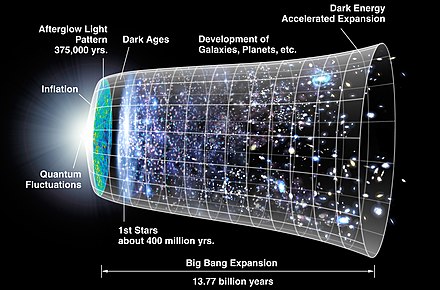Cosmological constant
In cosmology, the cosmological constant (usually denoted by the Greek capital letter lambda: Λ), alternatively called Einstein's cosmological constant, is the constant coefficient of a term Albert Einstein temporarily added to his field equations of general relativity. He later removed it. Much later it was revived and reinterpreted as the energy density of space, or vacuum energy, that arises in quantum mechanics. It is closely associated with the concept of dark energy.[1]
Einstein originally introduced the constant in 1917[2] to counterbalance the effect of gravity and achieve a static universe, a notion which was the accepted view at the time. Einstein abandoned the constant in 1931 after Hubble's confirmation of the expanding universe.[3] From the 1930s until the late 1990s, most physicists agreed with Einstein's retraction, assuming the cosmological constant to be equal to zero.[4] That changed with the surprising discovery in 1998 that the expansion of the universe is accelerating, implying the possibility of a positive value for the cosmological constant.[5]
Since the 1990s, studies have shown that, assuming the cosmological principle, around 68% of the mass–energy density of the universe can be attributed to so-called dark energy.[6][7][8] The cosmological constant Λ is the simplest possible explanation for dark energy, and is used in the current standard model of cosmology known as the ΛCDM model.
According to quantum field theory (QFT) which underlies modern particle physics, empty space is defined by the vacuum state which is a collection of quantum fields. All these quantum fields exhibit fluctuations in their ground state (lowest energy density) arising from the zero-point energy present everywhere in space. These zero-point fluctuations should act as a contribution to the cosmological constant Λ, but when calculations are performed these fluctuations give rise to an enormous vacuum energy.[9] The discrepancy between theorized vacuum energy from quantum field theory and observed vacuum energy from cosmology is a source of major contention, with the values predicted exceeding observation by some 120 orders of magnitude, a discrepancy that has been called "the worst theoretical prediction in the history of physics".[10] This issue is called the cosmological constant problem and it is one of the greatest mysteries in science with many physicists believing that "the vacuum holds the key to a full understanding of nature".[11]
Einstein included the cosmological constant as a term in his field equations for general relativity because he was dissatisfied that otherwise his equations did not allow, apparently, for a static universe: gravity would cause a universe that was initially at dynamic equilibrium to contract. To counteract this possibility, Einstein added the cosmological constant.[3] However, soon after Einstein developed his static theory, observations by Edwin Hubble indicated that the universe appears to be expanding; this was consistent with a cosmological solution to the original general relativity equations that had been found by the mathematician Friedmann, working on the Einstein equations of general relativity. Einstein reportedly referred to his failure to accept the validation of his equations—when they had predicted the expansion of the universe in theory, before it was demonstrated in observation of the cosmological redshift—as his "biggest blunder".[12]
In fact, adding the cosmological constant to Einstein's equations does not lead to a static universe at equilibrium because the equilibrium is unstable: if the universe expands slightly, then the expansion releases vacuum energy, which causes yet more expansion. Likewise, a universe that contracts slightly will continue contracting.[13]

